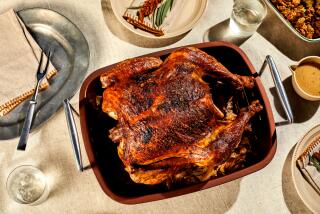Recipe: Rosemary-Meyer lemon turkey with wilted escarole
- Share via
Total time: About 4 hours, depending on the size of the bird
Servings: 8
Note: Brining results in an incomparably moist, flavorful turkey. Combine 2/3 cup salt with 1 gallon of water in a large stockpot or clean pail. Add the turkey and let it soak overnight in the refrigerator. Remove the turkey early the day of roasting, pat it dry and set it in the refrigerator uncovered to air-dry for at least an hour.
6 sprigs fresh rosemary (choose the most tender young sprigs from the outside of the plant)
1 (10- to 12-pound) turkey
Salt
1/2 cup (1 stick) butter
3 cloves garlic, smashed but not pureed
Juice and zest of 1 Meyer lemon (or combination of half lemon and half orange), plus more if necessary
3 heads escarole
Freshly ground pepper
1. Blanch the rosemary in rapidly boiling water for 10 to 15 seconds. This will further tenderize the sprigs and will also make your kitchen smell great. Pat dry and set aside.
2. Remove the giblets and rinse the turkey thoroughly under cold, running water. If you want to brine it, do so the day before serving. Thoroughly pat the turkey dry with a tea towel. Pull up the skin covering the breast on both sides of the central “keel” bone. Do not remove the skin, just separate it from the meat enough so that you can stick your fingers in between. Do the same with the skin on the inside of the thighs.
3. Insert 2 sprigs of rosemary under the skin of each breast, being careful not to bend or break the stems. In the same manner, insert 1 sprig of rosemary under the skin of each thigh. If the turkey has not been brined, salt it well inside and out.
4. Heat the oven to 350 degrees.
5. Heat the butter, garlic and the juice and zest of the Meyer lemon in a small saucepan over medium-low heat until the garlic begins to soften and become fragrant, about 5 minutes. Remove from the heat, but keep warm while the turkey is roasting.
6. Place the turkey breast-side down on a rack in a shallow-sided roasting pan. Brush with the butter and begin roasting the turkey in the oven. After 30 minutes, baste the turkey once more with the butter mixture, then turn the turkey so the breast side is up. Brush the breast side with the butter and continue roasting, basting every 30 minutes, until a thermometer inserted in the deep part of the thigh registers 165 degrees.
7. While the turkey is roasting, blanch the whole heads of escarole in plenty of rapidly boiling water just long enough for them to soften slightly, 1 to 2 minutes. Drain and press them dry, and cut out the tough bottoms and chop coarsely. Set aside.
8. Remove the turkey from the oven, brush with butter once more, cover loosely with foil and set aside for 15 minutes to rest before carving. While the turkey is resting, pour off all but 2 tablespoons of the grease from the roasting pan and add the blanched, chopped escarole to the pan. Return the pan to the oven and roast, stirring occasionally, about 15 minutes.
9. Carve the turkey, reserving some of the juices. (Be sure to remove the rosemary sprigs after carving, unless you have guests who are very fond of the flavor.) Taste the escarole in the roasting pan and add salt and a generous grinding of pepper, some of the carving juices and more lemon juice as necessary. Neither the flavors of the turkey nor the lemon should be pronounced. Rather, they should be accents to the bittersweet flavor of the escarole.
10. Place the escarole in the center of the turkey platter, arrange the carved bird over it and serve.
Each serving: 646 calories; 400 mg. sodium; 248 mg. cholesterol; 33 grams fat; 12 grams saturated fat; 1 gram carbohydrate; 80 grams protein; 0.32 gram fiber.


